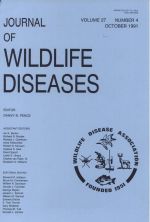Dynamics of communities of gastrointestinal helminths of cotton rats (Sigmodon hispidus) were monitored in response to five experimental brush management treatments using herbicide applications with and without prescribed burning on the Cross Timbers Experimental Range in Payne County, Oklahoma (USA). A total of 113 adult cotton rats (68 male and 45 female) was collected from experimental pastures in winter and summer 1986 resulting in the recovery of five species of helminths: Longistriata adunca, Syphacia sigmodontis, Strongyloides sp., Protospirura muris, and Raillietina sp. Prevalences of Raillietina sp. and S. sigmodontis were greater on control than herbicide-treated pastures. Prevalence and abundance of Raillietina sp. and prevalence of S. sigmodontis were significantly lower on annually burned, herbicide-treated pastures compared to unburned herbicide-treated pastures. Triclopyr-treated pastures had greater abundances of L. adunca and lower abundances of Raillietina sp. than those treated with tebuthiuron. Abundances of L. adunca also decreased from winter to summer on annually burned, herbicide-treated pastures while increasing on other pastures. Distribution of all helminths was overdispersed, but distribution of L. adunca showed a significant brush treatment by season interaction as a result of greater overdispersion in summer than winter for cotton rats inhabiting brush-treated pastures. Our results indicate that man-induced habitat modifications can alter hostparasite relationships in the community.
How to translate text using browser tools
1 October 1991
INFLUENCE OF HABITAT MODIFICATION ON THE COMMUNITY OF GASTROINTESTINAL HELMINTHS OF COTTON RATS
James F. Boggs,
Scott T. McMurry,
David M. Leslie Jr.,
David M. Engle,
Robert L. Lochmiller

Journal of Wildlife Diseases
Vol. 27 • No. 4
October 1991
Vol. 27 • No. 4
October 1991
Brush management
cotton rat
habitat modification
helminth community ecology
parasitism
prescribed burning
Sigmodon hispidus




